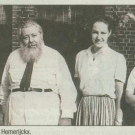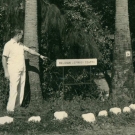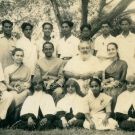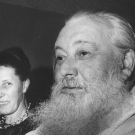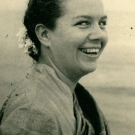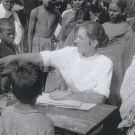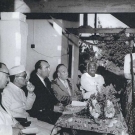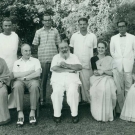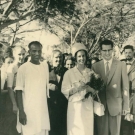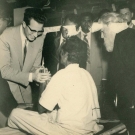The “Polambakkam adventure” begins July 1955. Or rather, we must first go back until 1953. In February this year, Belgium faces serious flooding on the coast and it appealed for international assistance. Shortly after, India responds to this call by sending large quantities of jute bags (for filling with sand) to fill holes in the dukes along the Belgian coast. Miracle of international solidarity : the “big” India is helping the “small” Belgium ! Touched by this solidarity, and at the instigation of Jesuit Fathers Moyersoen and Fallon who lived in India, a group of Belgian philanthropists — including Ernest Solvay, Joseph Maisin, encouraged by King Leopold III — wanted to show recognition of Belgium. Leprosy is endemic in India and Belgium has some experience in this field in the Congo, Belgium proposed to India to create a center for the treatment of leprosy, to make all investments (vehicles, buildings), to recruit and train the Indian staff needed to manage the center for a period of five years and then to hand it over to the Indian authorities in order to continue its management. A “Belgian Foundation for the fight against leprosy” was created and responsibility for the project was entrusted to Dr. Frans Hemerijckx, who had 25 years of experience in Congo. During his first trip to India, Dr. Hemerijckx will rather quickly select the village of Polambakkam, a few hundred kilometers south of Madras : “The area was known for a high prevalence of leprosy and the village was close to the Central Leprosy Teaching and Research Institute, an agency of the Federal Government, with whom we could collaborate in the future. We would be welcome. Dr. R. Cochrane had established at Polambakkam in the 40s, a center for epidemiological studies and for night segregation : infectious patients would spend the night there, thereby reducing contact with the family. At that time there was no effective drug and the only way to stop the disease was somehow to isolate them. From that experience, there were only a few buildings remaining.” (Claire Vellut, see her interview in AMA67 for further details).
AMA n°67 December 2010
Meanwhile, Dr. Hemerijckx met in Delhi, Claire and her two colleagues who had shown much enthusiasm to collaborate on this new project. Reaching Polambakkam, Dr. telegraphed them that he intended to start there the new center, asking them to wait one or two months to allow sufficient time to make bedrooms and living facilities. He received back a telegram : “We will arrive by train after tomorrow.” And thus 9 July 1955, 160 patients were received during the first consultation. The recent discovery (1943) of a new drug — dapsone, oral tablets — allowed indeed to “give new hope to patients : they could heal and nourish the hope to live a ‘normal’ life”. Polambakkam strategy was therefore to go to the patients and install the consultations in the villages, it was the famous “clinics under the trees”. Thus, month after month, the network of these consultations is widening on a region covering about 884 villages and 3.000 km ². Every morning 2 or 3 vehicles would leave Polambakkam with the doctor on board, paramedics, laboratory technicians, and all the necessary equipment (tables, chairs, microscope, patients’ sheets, etc.). According to distance and the number of patients at each consultation, each team would visit 1 – 3 “clinics under the trees”. As a principle, patients ould never be at more than 5 km walk, allowing them to lose less time to continue their daily work. During each consultation, they received their medication for 4 weeks, and every 4 weeks the mobile team would be back again, same place same timing. Dr. Hemerijckx liked to say that his 52 “clinics under the trees” were more punctual than trains ! In between consultations, paramedics stationed in each area were conducting a survey of all patients in the villages of their area, they were looking at the difficulties of the patients or at those who missed the monthly consultation, and they were giving advice for prevention and health education in schools.
At the Centre itself, a 50-bed hospital was built in 1957 to accommodate patients who suffered of acute stages of the disease, or needed reconstructive surgery. A small operations theatre, a physiotherapy depatment, laboratories, administrative buildings and residential quarters for the staff would complete the set-up. Photos and other documents will complete this very brief description of the startup and organisation of the Centre in Polambakkam, our concern here being only to briefly introduce the framework for Claire these 25 years to those who have never been there.
Claire reflects on Polambakkam (2011)
Let us go now through some of the events of Claire’s life during these 25 years.
Sept.19, 1955 : Official opening of the Centre by the Governor of Madras.
March 2, 1960 : visit of King Léopold III and Princess Liliane.
July 19, 1960 : The Polambakkam Centre is handed over to the Indian authorities. Dr. Hemerijckx will become a consultant to the WHO for the national program against leprosy. The Madras government requests to Dr. Claire Vellut to continue tthe management of the Centre. It was a paradoxical situation : a government department headed by a foreign private person ! Claire was establishing the budget and received from the government the required funds to pay the staff (including a small “honorarium” for herself) and to ensure all operations. Initially planned for 5 years, the agreement signed between the government and Claire was renewed until 1980.
From January 1963 to March 1966, Jacques, Claire ‘s nephew and his wife Francine joined the team. As they were both social workers, the idea of Claire was to take advantage of the large number of recorded and monitored patients in the region to achieve certain sociological and epidemiological investigations and check what could be the influence of certain social and environmental factors on the spread of the disease. But the logistics did not follow (it took three years to receive an additional vehicle, essential to go to the villages !). And Jacques and Francine were busy in Anandapuram, participating in the surveys in villages and schools, and other social and logistical activities. In November 1964, Claire was very touched to accompany Francine for the delivery of Olivier in Madras.
February 11, 1964 : Official visit of King Baudouin and Queen Fabiola, and celebration of the XI World Leprosy Day in the presence of Follereau and his wife.
In 1964, creation of a home — “The Beatitudes” or “Anandapuram” — which would welcome the patients “clinically cured” but with mutilations as a result of the disease, and who were alone or not easily accepted in their family. Construction of the center has been possible thanks to a generous lady in Belgium, but afterwards it has been fully funded by the Damien Foundation. Anandapuram has been caring for upto thirty residents at a time, men and women, many of whom were involved in various occupations : vegetable garden, crops, small scale crafts. The centre is still active today, although the inmates are becoming older and older, and during the time she stayed in Polambakkam, Claire apprecaited to visit almost daily Anandapuram.
In 1965, the quality of its work being increasingly appreciated and recognized the medical authorities of Madras asked the Polambakkam centre to train paramedical workers specialized in leprosy for the whole State of Tamil Nadu. Several groups of 30 to 50 young men and women have been attending the 6-month course in Polambakkam, every 6 months, requiring new constructions for trainees quarters and classrooms.
In the period until 1980, the guestbook of Polambakkam reflects the many visitors, more or less “famous” — friends, family, medical staff — from India and abroad, who were welcomed by Claire. Naming them here would be impossible, as would be impossible also to name all the members of staff who accompanied Claire in her work. Claire maintained friendly relations with most of them. But we can refer to some pictures or stories that appear (or will appear) in other parts of this “book”. Readers should not hesitate to notify us of other events more or less importants of which we have no memory immediately now or we have not found evidence so far …
However, the last event to report in this period is of great importance for Claire. It is indeed on June 14, 1979 that Claire was notified her Indian citizenship ! It had required multiple steps from her part, she had to hand over hers Belgian passport to her embassy, she could not go out of India for many months until all the paperwork was over, and she even had to pass a test proving her sufficient knowledge of an Indian language: Claire was not gifted for foreign languages. She had an interview of a few minutes (in Tamil ) with a senior officer… who gave her the benefit of the doubt ! But Claire did not stop there : she followed diligently Hindi courses by correspondence and in 1982, she passed an examination in Hindi where she earned the distinction (152/ 200) ? Getting Indian citizenship was for Claire one of her dearest wishes, which would allow her to live in India throughout his life.
In September 1980 Claire leaves Polambakkam — but we’ll see she will come back many times ! — and passes on the management to one of her Indian colleagues [among all doctors in Polambakkam, we do not remember which one immediately succeeded Claire.]

